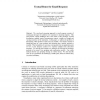Free Online Productivity Tools
i2Speak
i2Symbol
i2OCR
iTex2Img
iWeb2Print
iWeb2Shot
i2Type
iPdf2Split
iPdf2Merge
i2Bopomofo
i2Arabic
i2Style
i2Image
i2PDF
iLatex2Rtf
Sci2ools
EWCBR
2004
Springer
2004
Springer
Textual Reuse for Email Response
The case-based reasoning approach to email response consists of reusing past messages to synthesize new responses to incoming requests. This task presents various challenges due to the nature of the messages: Textual descriptions, multiple topics, heterogeneous content, variable text length and varying recurrence of the statements. In this paper, we address the problem of determining which portions of past cases are reusable. Our scheme consists of identifying parts of a past message and declaring them variable, optional or reusable. This formulation of case reuse corresponds, from an application point of view, to the dynamic creation of a response template from antecedent messages. We describe and compare two strategies for selecting the messages portions to be reused: Case grouping and condensation models. Our results indicate that the case grouping strategy is a better choice. We also describe some of our experiments for identifying variable parts, based on named entity extraction t...
Artificial Intelligence | Case-Based Reasoning Approach | EWCBR 2004 | Past Message | Variable Text Length |
| Added | 01 Jul 2010 |
| Updated | 01 Jul 2010 |
| Type | Conference |
| Year | 2004 |
| Where | EWCBR |
| Authors | Luc Lamontagne, Guy Lapalme |
Comments (0)

